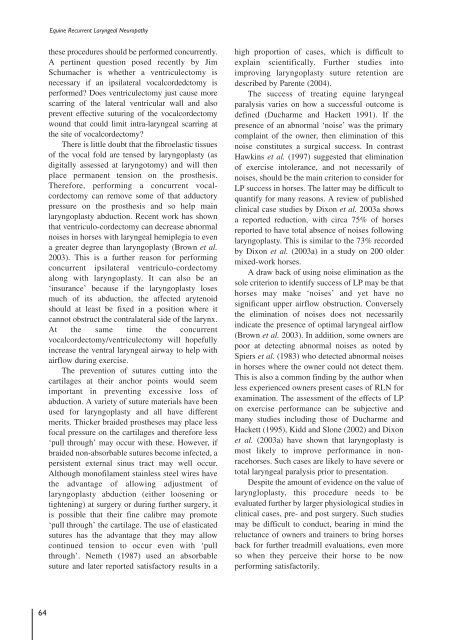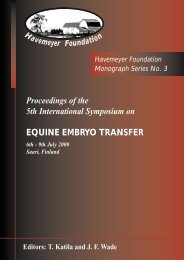Proceedings of a Workshop on - The Havemeyer Foundation
Proceedings of a Workshop on - The Havemeyer Foundation
Proceedings of a Workshop on - The Havemeyer Foundation
You also want an ePaper? Increase the reach of your titles
YUMPU automatically turns print PDFs into web optimized ePapers that Google loves.
Equine Recurrent Laryngeal Neuropathy<br />
these procedures should be performed c<strong>on</strong>currently.<br />
A pertinent questi<strong>on</strong> posed recently by Jim<br />
Schumacher is whether a ventriculectomy is<br />
necessary if an ipsilateral vocalcordedctomy is<br />
performed? Does ventriculectomy just cause more<br />
scarring <str<strong>on</strong>g>of</str<strong>on</strong>g> the lateral ventricular wall and also<br />
prevent effective suturing <str<strong>on</strong>g>of</str<strong>on</strong>g> the vocalcordectomy<br />
wound that could limit intra-laryngeal scarring at<br />
the site <str<strong>on</strong>g>of</str<strong>on</strong>g> vocalcordectomy?<br />
<strong>The</strong>re is little doubt that the fibroelastic tissues<br />
<str<strong>on</strong>g>of</str<strong>on</strong>g> the vocal fold are tensed by laryngoplasty (as<br />
digitally assessed at laryngotomy) and will then<br />
place permanent tensi<strong>on</strong> <strong>on</strong> the prosthesis.<br />
<strong>The</strong>refore, performing a c<strong>on</strong>current vocalcordectomy<br />
can remove some <str<strong>on</strong>g>of</str<strong>on</strong>g> that adductory<br />
pressure <strong>on</strong> the prosthesis and so help main<br />
laryngoplasty abducti<strong>on</strong>. Recent work has shown<br />
that ventriculo-cordectomy can decrease abnormal<br />
noises in horses with laryngeal hemiplegia to even<br />
a greater degree than laryngoplasty (Brown et al.<br />
2003). This is a further reas<strong>on</strong> for performing<br />
c<strong>on</strong>current ipsilateral ventriculo-cordectomy<br />
al<strong>on</strong>g with laryngoplasty. It can also be an<br />
‘insurance’ because if the laryngoplasty loses<br />
much <str<strong>on</strong>g>of</str<strong>on</strong>g> its abducti<strong>on</strong>, the affected arytenoid<br />
should at least be fixed in a positi<strong>on</strong> where it<br />
cannot obstruct the c<strong>on</strong>tralateral side <str<strong>on</strong>g>of</str<strong>on</strong>g> the larynx.<br />
At the same time the c<strong>on</strong>current<br />
vocalcordectomy/ventriculectomy will hopefully<br />
increase the ventral laryngeal airway to help with<br />
airflow during exercise.<br />
<strong>The</strong> preventi<strong>on</strong> <str<strong>on</strong>g>of</str<strong>on</strong>g> sutures cutting into the<br />
cartilages at their anchor points would seem<br />
important in preventing excessive loss <str<strong>on</strong>g>of</str<strong>on</strong>g><br />
abducti<strong>on</strong>. A variety <str<strong>on</strong>g>of</str<strong>on</strong>g> suture materials have been<br />
used for laryngoplasty and all have different<br />
merits. Thicker braided prostheses may place less<br />
focal pressure <strong>on</strong> the cartilages and therefore less<br />
‘pull through’ may occur with these. However, if<br />
braided n<strong>on</strong>-absorbable sutures become infected, a<br />
persistent external sinus tract may well occur.<br />
Although m<strong>on</strong><str<strong>on</strong>g>of</str<strong>on</strong>g>ilament stainless steel wires have<br />
the advantage <str<strong>on</strong>g>of</str<strong>on</strong>g> allowing adjustment <str<strong>on</strong>g>of</str<strong>on</strong>g><br />
laryngoplasty abducti<strong>on</strong> (either loosening or<br />
tightening) at surgery or during further surgery, it<br />
is possible that their fine calibre may promote<br />
‘pull through’ the cartilage. <strong>The</strong> use <str<strong>on</strong>g>of</str<strong>on</strong>g> elasticated<br />
sutures has the advantage that they may allow<br />
c<strong>on</strong>tinued tensi<strong>on</strong> to occur even with ‘pull<br />
through’. Nemeth (1987) used an absorbable<br />
suture and later reported satisfactory results in a<br />
high proporti<strong>on</strong> <str<strong>on</strong>g>of</str<strong>on</strong>g> cases, which is difficult to<br />
explain scientifically. Further studies into<br />
improving laryngoplasty suture retenti<strong>on</strong> are<br />
described by Parente (2004).<br />
<strong>The</strong> success <str<strong>on</strong>g>of</str<strong>on</strong>g> treating equine laryngeal<br />
paralysis varies <strong>on</strong> how a successful outcome is<br />
defined (Ducharme and Hackett 1991). If the<br />
presence <str<strong>on</strong>g>of</str<strong>on</strong>g> an abnormal ‘noise’ was the primary<br />
complaint <str<strong>on</strong>g>of</str<strong>on</strong>g> the owner, then eliminati<strong>on</strong> <str<strong>on</strong>g>of</str<strong>on</strong>g> this<br />
noise c<strong>on</strong>stitutes a surgical success. In c<strong>on</strong>trast<br />
Hawkins et al. (1997) suggested that eliminati<strong>on</strong><br />
<str<strong>on</strong>g>of</str<strong>on</strong>g> exercise intolerance, and not necessarily <str<strong>on</strong>g>of</str<strong>on</strong>g><br />
noises, should be the main criteri<strong>on</strong> to c<strong>on</strong>sider for<br />
LP success in horses. <strong>The</strong> latter may be difficult to<br />
quantify for many reas<strong>on</strong>s. A review <str<strong>on</strong>g>of</str<strong>on</strong>g> published<br />
clinical case studies by Dix<strong>on</strong> et al. 2003a shows<br />
a reported reducti<strong>on</strong>, with circa 75% <str<strong>on</strong>g>of</str<strong>on</strong>g> horses<br />
reported to have total absence <str<strong>on</strong>g>of</str<strong>on</strong>g> noises following<br />
laryngoplasty. This is similar to the 73% recorded<br />
by Dix<strong>on</strong> et al. (2003a) in a study <strong>on</strong> 200 older<br />
mixed-work horses.<br />
A draw back <str<strong>on</strong>g>of</str<strong>on</strong>g> using noise eliminati<strong>on</strong> as the<br />
sole criteri<strong>on</strong> to identify success <str<strong>on</strong>g>of</str<strong>on</strong>g> LP may be that<br />
horses may make ‘noises’ and yet have no<br />
significant upper airflow obstructi<strong>on</strong>. C<strong>on</strong>versely<br />
the eliminati<strong>on</strong> <str<strong>on</strong>g>of</str<strong>on</strong>g> noises does not necessarily<br />
indicate the presence <str<strong>on</strong>g>of</str<strong>on</strong>g> optimal laryngeal airflow<br />
(Brown et al. 2003). In additi<strong>on</strong>, some owners are<br />
poor at detecting abnormal noises as noted by<br />
Spiers et al. (1983) who detected abnormal noises<br />
in horses where the owner could not detect them.<br />
This is also a comm<strong>on</strong> finding by the author when<br />
less experienced owners present cases <str<strong>on</strong>g>of</str<strong>on</strong>g> RLN for<br />
examinati<strong>on</strong>. <strong>The</strong> assessment <str<strong>on</strong>g>of</str<strong>on</strong>g> the effects <str<strong>on</strong>g>of</str<strong>on</strong>g> LP<br />
<strong>on</strong> exercise performance can be subjective and<br />
many studies including those <str<strong>on</strong>g>of</str<strong>on</strong>g> Ducharme and<br />
Hackett (1995), Kidd and Sl<strong>on</strong>e (2002) and Dix<strong>on</strong><br />
et al. (2003a) have shown that laryngoplasty is<br />
most likely to improve performance in n<strong>on</strong>racehorses.<br />
Such cases are likely to have severe or<br />
total laryngeal paralysis prior to presentati<strong>on</strong>.<br />
Despite the amount <str<strong>on</strong>g>of</str<strong>on</strong>g> evidence <strong>on</strong> the value <str<strong>on</strong>g>of</str<strong>on</strong>g><br />
laryngloplasty, this procedure needs to be<br />
evaluated further by larger physiological studies in<br />
clinical cases, pre- and post surgery. Such studies<br />
may be difficult to c<strong>on</strong>duct, bearing in mind the<br />
reluctance <str<strong>on</strong>g>of</str<strong>on</strong>g> owners and trainers to bring horses<br />
back for further treadmill evaluati<strong>on</strong>s, even more<br />
so when they perceive their horse to be now<br />
performing satisfactorily.<br />
64








